Since I have embarked on my journey in the development sector, program design for a large-scale intervention has always fascinated me. Recently, I got an opportunity to be a part of the Summer Camp-‘CAMaL Ka Camp’ implementation across the communities of all 75 districts of Uttar Pradesh with the support of volunteers. Advertently, the aim is to also empower the volunteers through certain skills helpful for them in their lives.
During my field visit to Malihabad block in the state, I did not go with much of a planning to see and learn certain things, yet came back with a decent understanding on how different aspects of the program are weaved together to make it ‘complete’. This note is a reflection of my understanding on designing an effective large-scale intervention like this and the journey of a Community Instructor Mobiliser (CIM) during the multiple phases of its implementation.
Taking the road less travelled — Journey of CIMs in the implementation: The program design for the summer camp is done by the senior leadership of the team but the sole responsibility of implementing it is in the hands of teams scattered across the state. Without their dedicated support to work relentlessly in the scorching heat, it was impossible to see the efficacy of the program. Post their training, in the mobilisation phase of this campaign, the CIMs started spreading to the mapped allocations, liaising with different stakeholders and disseminating the purpose and the impact of this campaign for the targeted group of children.
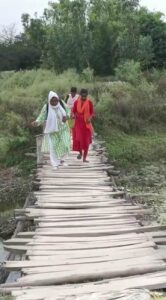 As Ishrat and I headed together to the villages to visit campaign classes, she shared stories of how she, along with her two colleagues, managed to cover the remotest villages of the block wherein Pratham had never worked before. The challenges were immense but her urge to explore something new, meet new people and apply her previous experiences led her to push herself and cope up with the challenges coming her way. She shared that while they were traveling from Ladhausi village to Kannar village, they had to cross a river stream on a wooden bridge. Lack of conveyance was a huge problem in some of the villages and they even had to take lift from a pickup vehicle where the road was under construction in the Malha village. Once when they were coming back from Bahelia village, they suffered honey bee stings.
As Ishrat and I headed together to the villages to visit campaign classes, she shared stories of how she, along with her two colleagues, managed to cover the remotest villages of the block wherein Pratham had never worked before. The challenges were immense but her urge to explore something new, meet new people and apply her previous experiences led her to push herself and cope up with the challenges coming her way. She shared that while they were traveling from Ladhausi village to Kannar village, they had to cross a river stream on a wooden bridge. Lack of conveyance was a huge problem in some of the villages and they even had to take lift from a pickup vehicle where the road was under construction in the Malha village. Once when they were coming back from Bahelia village, they suffered honey bee stings.
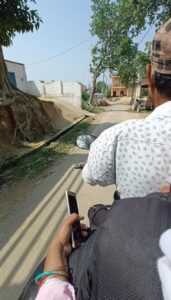 All of these challenges proved to be fruitful when they reached the inside of the villages, identified volunteers and met the children. It was surprising to her that in these untouched locations, people are still struggling with the lack of basic provisions, such as government schools with decent infrastructure, financial problems prevailing in the families, no proper roads and transport, and lack of awareness amongst families. This was all a huge experience for her and she makes sure that she shares her daily experiences with her child, so that he learns, and husband because she is grateful for his support during this mission. When I asked her about the grit and courage in her, with a gentle smile on her face, she said, “ABC nahi pata tha par ab lagta hai ki sab aata hai, hum kaam karte gaye aur raaste khud hi nikalte gaye”. As we stepped down the bus to head to Budharia village, we waited for quite some time to find a vehicle but could not get one. Finally, we took lift from someone, tripled on a two-wheeler and headed to the village. While it was a unique experience for me, it was not easy and I wonder how the CIMs do this frequently. It is inspiring to see hundreds of such brave hearts on the field implementing this program across the state.
All of these challenges proved to be fruitful when they reached the inside of the villages, identified volunteers and met the children. It was surprising to her that in these untouched locations, people are still struggling with the lack of basic provisions, such as government schools with decent infrastructure, financial problems prevailing in the families, no proper roads and transport, and lack of awareness amongst families. This was all a huge experience for her and she makes sure that she shares her daily experiences with her child, so that he learns, and husband because she is grateful for his support during this mission. When I asked her about the grit and courage in her, with a gentle smile on her face, she said, “ABC nahi pata tha par ab lagta hai ki sab aata hai, hum kaam karte gaye aur raaste khud hi nikalte gaye”. As we stepped down the bus to head to Budharia village, we waited for quite some time to find a vehicle but could not get one. Finally, we took lift from someone, tripled on a two-wheeler and headed to the village. While it was a unique experience for me, it was not easy and I wonder how the CIMs do this frequently. It is inspiring to see hundreds of such brave hearts on the field implementing this program across the state.
Designing an effective large-scale intervention: One of the things that excites me is the involvement of different stakeholders at various levels and going beyond the usual geography, therefore, giving rise to more complex challenges of working with diverse people in the system.
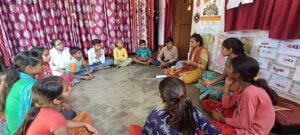 Volunteering is that kind of effort that can selflessly fuel in ‘the sense of possibility’ in anybody and preparing volunteers even at the remotest villages of Uttar Pradesh at this scale is just not easy! The state has reached more than one lakh volunteers in a very short period. Sneha, a volunteer in Budharia village, is a student enrolled for B.Sc and she likes to engage with the children and learn the art of teaching.
Volunteering is that kind of effort that can selflessly fuel in ‘the sense of possibility’ in anybody and preparing volunteers even at the remotest villages of Uttar Pradesh at this scale is just not easy! The state has reached more than one lakh volunteers in a very short period. Sneha, a volunteer in Budharia village, is a student enrolled for B.Sc and she likes to engage with the children and learn the art of teaching.
Simpler and clearer goals for the children, our primary beneficiaries, is another important aspect of the program, which made it fairly easier for the volunteers to follow. The primary objective of this campaign is to strengthen the foundational skills of Grade VI children struggling to read and perform basic number operations. During the visits to different volunteer classes, I could see many children at beginner, letter or word level during the baseline assessments but I also witnessed them learning to read and progressing.
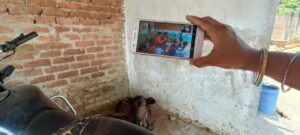 Another important aspect of the program is the use of technology in such large-scale interventions for training, mentoring, monitoring and tracking. COVID-19 may have shown us the worst but it has certainly made us more user friendly to digital devices and provided an opportunity to explore the endless possibilities of technology. For instance, it has enabled Ishrat in exploring both ways of offline and online monitoring for the volunteers under her purview across 33 villages. While physically she was present in Budharia village, she could also observe the classes taken by Kamini, a volunteer in Fatehnagar village, in real time and later provide her feedback.
Another important aspect of the program is the use of technology in such large-scale interventions for training, mentoring, monitoring and tracking. COVID-19 may have shown us the worst but it has certainly made us more user friendly to digital devices and provided an opportunity to explore the endless possibilities of technology. For instance, it has enabled Ishrat in exploring both ways of offline and online monitoring for the volunteers under her purview across 33 villages. While physically she was present in Budharia village, she could also observe the classes taken by Kamini, a volunteer in Fatehnagar village, in real time and later provide her feedback.
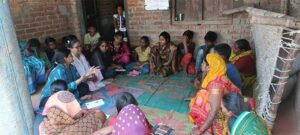 Mobilising and preparing young people to voluntarily engage with children for 6 weeks may have been a tougher task but creating awareness among parents and convincing them to send their children to camp classes regularly with the preconceived notion of ‘padh likh kar kya karega’ is the toughest task! During a visit to another volunteer class in Allupur village, Kajal shared her challenge on how children do not come to classes, and every day she and her sister had to go door to door to call the children and engage them in teaching and learning activities. Upfront, she requested me to speak to the mothers, disseminate the importance of these classes and encourage them to send their children regularly. In no time, they organised a mothers’ meeting and I hope that witnessing their child reading a paragraph through their own eyes may have shifted their perspectives a little.
Mobilising and preparing young people to voluntarily engage with children for 6 weeks may have been a tougher task but creating awareness among parents and convincing them to send their children to camp classes regularly with the preconceived notion of ‘padh likh kar kya karega’ is the toughest task! During a visit to another volunteer class in Allupur village, Kajal shared her challenge on how children do not come to classes, and every day she and her sister had to go door to door to call the children and engage them in teaching and learning activities. Upfront, she requested me to speak to the mothers, disseminate the importance of these classes and encourage them to send their children regularly. In no time, they organised a mothers’ meeting and I hope that witnessing their child reading a paragraph through their own eyes may have shifted their perspectives a little.
Building good to great: While the efforts for the children during summer months is incomparable, the only hope is that the improved learning levels are sustained when the children are back to school after the vacation.
-Ruchi Anand, Associate (Program Management Group)
PS: This write-up has been published in its original form without any editing or alterations. Any grammatical errors, typos, or stylistic variations are preserved to maintain the authenticity of the author’s work. The views and opinions expressed here are those of the individual authors and do not reflect the views or positions of the organisation.
